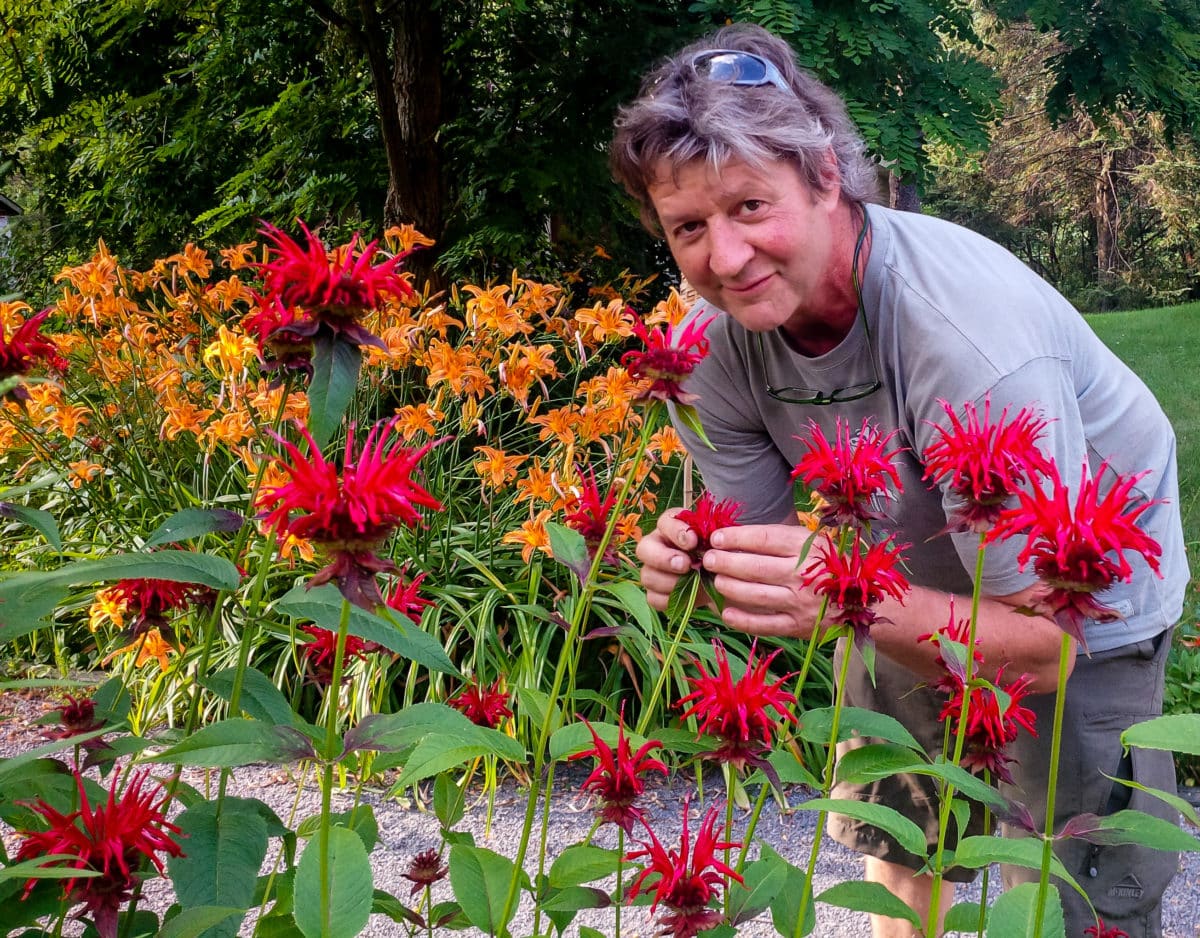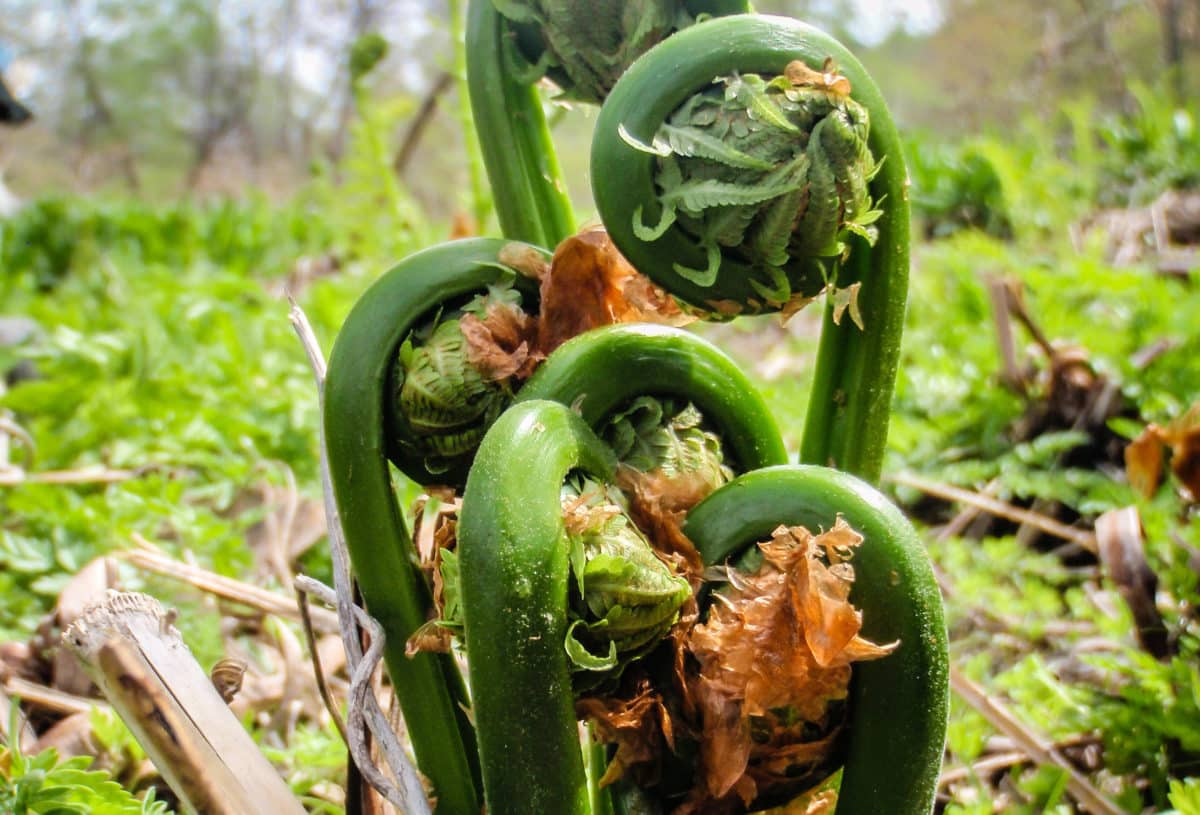For Les Jardins Sauvages, our restaurant in Quebec, Canada, that specializes in wild edibles, spring is an exciting time and May marks the beginning of our relentless race/dance with Mother Nature. After fifteen years in cooking wild things it has yet to get old.
Each season is at once comforting, with the same favorites coming back, and thrilling, because we haven’t seen them in a year. And each year is unpredictable; we’re always in for a few surprises.
Our yearly cycle is less like clockwork than conventional farming; we are out prospecting as soon as the maple sap stops running and the snow is about gone. As we walk through the woods, the first tell-tale signs of spring we detect are olfactory. Before any little splotches of green appear, the invigorating “smell of green” hits the nose up front, the damp earth, muddy back notes falling behind, while the unmistakable pungent scent of wild garlic and crinkleroot sporadically wakes up the nose with a tingle. Bend down and brush the ground cover aside and, sure enough, a whole new promising world of micro shoots opens up.
The first sprouts to show up in any forest around here are the mottled leaves of the trout lily – grassy and fruity, slightly astringent, they taste like “spring” to me; François says cantaloupe. Mixed in and around the maple grove, there is also Spring-Beauty, which tastes like corn shoots, and bellwort, composing the pretty part of our spring mesclun, Crinkleroot leaf and garlic mustard will be added to the salad to provide bite. In the neighboring meadows, we find the rest of our mix – dandelion, daisy and linden, each providing its own texture and taste: piquant, sweet and liquorice-y, rich and nutty. All that is missing in our salad bowl at this point are a few ramp leaves for heady punch. After a long winter, this energizing cocktail of chlorophyll and crunch, phytochemicals and minerals, is just what the body craves, and for the next month, we will gorge on green. It will be two to three weeks until the canopy of foliage is in, bringing the season to an end for these fleeting spring edibles, and we will move on to violet, daisy, live forever, dame’s rocket, lady sorrel, lovage, chickweed and lamb’s quarters for salad in June, adding marine greens in July. June is tops for abundance and variety thanks to the ever-mysterious crossover from spring to summer, but you have to be on your toes and in the woods. The short time frame normally makes for natural built-in sustainability in the wild.
Of course, to leave some behind when foraging is only common sense for nature lovers, and as François’ grandmother Ida used to say, we must not forget about the birds and the bees. But before you go picking anything, you have to know what you’re doing. Not just that a given specimen is indeed edible and allowed and that the land is not polluted; it is crucial to know the cycle of each plant. There is a time and a place and a way to pick properly. Dandelion is best picked young and early in the day, blossoms at noon. The terroir and weather are determinate – fiddleheads are tender and live forever lush

from shady, humid spots, while tough and acrid in sunny poor soil; lovage can range from powerful-and-bitter to mild-and-sweet, sea chickweed from tasty to inedible depending on the year or place. And it’s not only important to get each at its best taste and nutrient wise, but also to ensure the future health of the plant population. Basically, it comes down to cutting and pruning, as opposed to pulling out the roots, unless it is an invasive weed in your garden. If Quebeckers had been more careful, maybe ramps* would not be illegal today. Sticking to your backyard or the same spots time and again, you see the impact of your harvest, which is key for a keen forager.
Arguably less touchy is our other spring star, the ostrich fern, aka fiddlehead. The highlight of our spring (and the bulk of our work) revolves around fiddleheads. The earliest local vegetable of the season, they are a popular rite of spring for Quebeckers. On our property alone, we harvest tons every year. Picked when young, immediately after breaking ground and before they unfurl, we snap a couple from each cluster, then the arduous washing process begins before going to market. We have a day or two in each microclimate to hit the jackpot. The fresher the better; I try to cook them within 48 hours of being picked, putting hundreds of pounds up in the form of pickles or blanched and vacuum-packed for the freezer.
There is no need to be afraid of fiddleheads when properly sourced — so healthy and versatile, the most important thing is that they need to be cooked, like most wild vegetables. In lots of boiling salted water for a blanch/first cooking, and then they are ready for the pan or to add to any recipe.
Across Quebec the season lasts until early June, at which point lambs’ quarters, milkweed and various buds become the wild vegetables of the hour. Later we will have cattails, sea rocket, and sea spinach. And wild mushrooms of course! ![]()
* Let’s talk about ramps. In Quebec, it is illegal to harvest over 50 bulbs of ramps privately, not at all commercially, or even to have imported ramps on a restaurant menu. That is because they are slow to reproduce (seven+ years from seed) and have been over-harvested because Quebeckers have always loved eating them, long before foraging became trendy. All could have been fine if a few reckless opportunists hadn’t wrecked it for everybody, if they had harvested correctly and not too much, never ripping out the roots. François’ grandfather taught him to pick them with a spoon. Hence, fifty years later, we have tons of ramps on our property. We do eat the odd bulb but are mostly satisfied with the leaves that we clip at the end of the cycle. Crinkleroot and wild ginger are two other plants we love that need extra care; they are slow to reproduce and so they are on the government’s endangered list, but on good land and in the right hands, provide plenty.
Granted, more biodiversity has been lost to urban sprawl, condos, and parking lots than to over-zealous foragers. Still it is especially important now that foraging has gone hipster that people be informed, not going around destroying the environment. Before, foragers were automatically connected to nature, now there are all kinds. Inevitably and thankfully, comprehensive regulation is being drawn up in Quebec.
A few ideas…
Fiddleheads with Garlic, Tamari and Cider Vinegar
These are excellent as an accompaniment to a meal, as part of a composed salad, or in an omelette or pasta dish.
I also like to make a Rockefeller ** mix with the first of the fiddleheads and the last hurrah of oysters. Fiddleheads are equally good in a stir-fry or curry, or served cold or hot dressed with ginger, lime, chile, miso and sesame oil.
** Oysters Rockefeller is an old school/still-popular recipe for oysters broiled with a topping of creamed onion, bacon, spinach, cheese, and egg.
Wild Green Salad
All that such tasty greens*** need is a good oil – a cold pressed olive oil or nut oil – and a pinch of salt. After that, anything is bonus. A few drops of aged (sweet) vinegar and some scallions would be a starting point. Then maybe some umami and extra-crispy crunch to soften the green and bitter notes (aged cheese shards, nuts are at the top of the list, then bacon, egg, pickled mushrooms, olives). Add avocado, chicken, shrimp, etc., to make it a meal.
With wild greens it is a good idea to season with oil and salt and let sit for an hour if you prefer softer flavors and aren’t in a rush. They are hearty enough to retain some texture. But if it’s fresh pungent crunch you’re after, dig right in.
You can always stretch the wild greens by mixing in some cultivated lettuce, say Romaine or Boston, if you didn’t score that day or to make it kid-friendly.
*** Wash greens well in lots of fresh water and spin dry before dressing.
